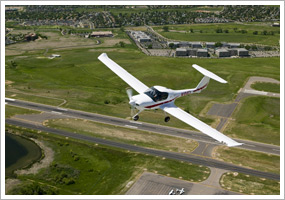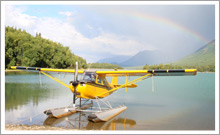Feb. 25, 2011, issue of 'AOPA ePilot: Flight Training Edition' newsletter
| ||||
| | FT News | INSIDE AOPA | TRAINING PRODUCTS | FINAL EXAM | |||
TRAINING TIPsWhat’s next? What else should a pilot be able to visualize a few minutes in advance? The traffic pattern entry—and there’s more to it than entering the proper pattern to the proper runway. Correcting for wind drift and changing groundspeed on the downwind, base, and final legs requires visualization. Suppose you determined from the ATIS broadcast that there will be a strong left crosswind on final. When flying the left downwind, will that wind cause you to drift toward the runway, or away from it, if left uncorrected? Turning left base, will your groundspeed decrease, or increase? Visualizing the conditions would help you avoid drifting too close on downwind or overshooting the final turn. If your flight instructor has asked you questions like these in the cockpit or on the ground, it’s because probing your ability to visualize is part of assessing your readiness to solo. Correct responses on your part demonstrate that you have learned how to transfer knowledge from your flight exercises, such as ground reference maneuvers, to the en route environment and the traffic pattern, as discussed in the answer to the Feb. 23, 2007, Final Exam question, which notes: “With practice it will become second nature to divide your attention between the mechanics of making the turn and the subtleties of adjusting the turn rate as needed to compensate for wind drift.” Speaking of the traffic pattern, being able to visualize where to spot reported traffic depends on your familiarity with pattern operations and knowing a bit about other aircraft types (see the Jan. 10, 2003, “Training Tip: Name that Plane” ), such as their approximate approach speeds. YOUR PARTNER IN TRAININGThe checklist is one of the least expensive yet most effective safety devices available in the cockpit. Not following a checklist could have dire consequences. Check out this informative article from Flight Training magazine and continue to search the magazine's archives for a wealth of information to help you achieve your goal of obtaining your pilot certificate.
Did you know that student pilots who join AOPA are three times more likely to complete their flight training? Membership includes unlimited access to aviation information by phone (800/USA-AOPA, weekdays from 8:30 a.m. to 6 p.m. Eastern time) or from Flight Training Online or AOPA Online. If you're not already a member, join today and get the pilot’s edge. Login information is available online. FLIGHT TRAINING NEWSNew pilots key to future of aviationAs government and industry leaders discussed how to meet future challenges through innovation at the FAA Aviation Forecast Conference Feb. 15 and 16, AOPA zeroed in on a human factor: What’s aviation without pilots? The FAA’s 20-year forecast projects slow growth of general aviation hours through 2031. An AOPA representative explained how the association is building on findings from a 2010 study of the flight training experience to address high student pilot attrition rates. Read more >> Opening skies to womenTo celebrate Women of Aviation Worldwide Week, March 7 through 13, the aviation community will showcase its female members and welcome newcomers with first flights, contests, and more. “The women of the past cracked the doors open; we intend to open them wide,” said international organizer Mireille Goyer. There are fewer women flying today—approximately 35,000, including those with student pilot certificates—than there were 15 years ago, she said. Read more >> Test your airspace knowledgeYou probably know quite a bit about Class B, C, and D airspace—but would you recognize a VFR transition route if you saw one on a chart? What about a Mode C veil or a TRSA? This week’s Air Safety Institute Safety Quiz covers some of the basics (and not-so-basics) of airspace rules, procedures, and charting. Up for the challenge? Find out >> Skycatcher alights at Georgia flight schoolLanier Flight Center in Gainesville, Ga., took delivery of a new Cessna 162 Skycatcher in February. The Skycatcher is the first of three on order. Lanier said it is one of the first flight schools in the Southeast to acquire a Skycatcher. The flight school used Facebook to post updates on the Cessna 162’s arrival to Lanier’s location at Lee Gilmer Memorial Airport. Marv Golden launches new websiteThe popular Internet-based pilot shop Marv Golden Pilot Supplies said this week it launched a new website. Marvgolden.com, which claims to be the first pilot shop to sell on the Internet, has been updated with many new features. Read more >> Inside AOPALike your airspace hot or cold?If you’re always avoiding flight through special-use airspace, you could end up with some unnecessary longer flight legs, burning more fuel. Sure, some airspace is off limits to general aviation aircraft at all times. But there are exceptions: Check out Mission: Possible, an interactive online course brought to you by the Air Safety Institute, the U.S. Air Force, and the Department of Defense. Video clips and interactive flight-planning scenarios take you beyond special-use airspace definitions. Mission: Possible qualifies for AOPA Accident Forgiveness and the FAA Wings programs. Take the course >> New CATS testing center locationsCATS, the official testing company of AOPA, has opened new testing centers in Florida, Michigan, Montana, Utah, and Virginia, giving you even more access to state-of-the-art Windows-based software, same-day registration, instant test results, and a professional, distraction-free environment when taking your exam. As an AOPA member, you will receive a $10 discount on all FAA knowledge tests at any CATS testing center. See a listing of the new locations and download your $10 off CATS coupon. One-way rentals from $19.95 a dayIf you’re driving out of Florida, Alamo has a deal you won’t want to miss. One-way rentals on economy through full-size vehicles start at just $19.95 a day. Reserve your car today. By choosing AOPA member products you help to support AOPA’s daily efforts to maintain the freedom, safety, and affordability of general aviation. TRAINING PRODUCTSAirmiler tape measure from Aircraft SprucePlanning a long, long cross-country? The Pilot’s Airmiler tape measure is a durable metal tape measure that measures mileage on aeronautical charts. The tape measure includes sectional scale (1:500,000) on one side and world aeronautical chart scale (1:1,000,000) on the other. Kilometers, statute, and nautical miles are shown on both sides. It sells for $19.95 from Aircraft Spruce and Specialty. Note: Products listed have not been evaluated by ePilot editors unless otherwise noted. AOPA assumes no responsibility for products or services listed or for claims or actions by manufacturers or vendors. FINAL EXAMQuestion: How do I know if an airplane qualifies in the light sport category?
Answer: In order for the airplane to be considered a light sport aircraft it must fit the definition in the Federal Aviation Regulations Part 1: Definitions and Abbreviations. For instance, it must be “an aircraft, other than a helicopter or powered-lift, that since its original certification, has continued to meet the following: (1) A maximum takeoff weight of not more than—(i)1,320 pounds for aircraft not intended for operation on water; or (ii) 1,430 pounds for an aircraft intended for operation on water.” It also must not go faster than 120 knots CAS (calibrated airspeed) in level flight with maximum continuous power under standard atmospheric conditions at sea level. Those are just a few of the qualifiers. For more information on the light sport aircraft category, check out AOPA’s online information on sport pilot and light sport aircraft.
Got a question for our technical services staff? E-mail [email protected] or call the Pilot Information Center, 800/872-2672. Don’t forget the online archive of “Final Exam” questions and answers, searchable by keyword or topic. What’s New OnlineA pilot who wants a flying job might find work in unexpected places. Chip Wright describes some of those avenues and what they can mean for your long-term career goals in this week’s Flight Training blog. AOPA Career OpportunitiesEver dream of turning your passion for aviation into a career? We’re looking for an IT department coordinator/help desk, aviation technical specialist, financial analyst, program specialist—communications, and vice president of new product development and interactive marketing. To learn more about other AOPA career opportunities, visit AOPA Online. Picture Perfect
AVIATION EVENTS & WEATHER To include an event or to search all events in the calendar, visit AOPA Online. For airport details, including FBO fuel prices, see AOPA Airports. Flight Instructor Refresher ClinicsThe next Air Safety Institute Flight Instructor Refresher Clinics are scheduled in Ontario, Calif., and Virginia Beach, Va., March 5 and 6; Phoenix, Ariz., Orlando, Fla., and Baltimore, Md., March 12 and 13; Burlingame, Calif., and King of Prussia, Pa., March 19 and 20; Atlanta, Ga., Indianapolis, Ind., and Boston, Mass., April 2 and 3. For a complete schedule, see AOPA Online.
Can’t make it in person? Sign up for the CFI Refresher Online. Air Safety Institute Safety SeminarsAir Safety Institute Safety Seminars are scheduled in Rochester, Minn., and Portland, Ore., March 7; Cedar Rapids, Iowa, and Seattle, Wash., March 8; Bedford, Mass., and Bellevue, Neb., March 9; Olathe, Kan., March 10; Ypsilanti, Mich., March 14; Cleveland, Ohio, March 15; Columbus, Ohio, March 16; Northbrook, Ill., and Indianapolis, Ind., March 21; Birmingham, Ala., and Bolingbrook, Ill., March 22; Marietta, Ga., Rockford, Ill., and Gaithersburg, Md., March 23; St. Louis, Mo., March 24. Topics vary—for details and a complete schedule, see AOPA Online. | Advertisers Got news? Contact ePilot. Having difficulty using this service? Visit the ePilot Frequently Asked Questions now at AOPA Online or write to [email protected]. |
| Member Tools : Send feedback | ePilot Archive Editorial Team: ePilot Flight Training Editor : Jill W. Tallman | ePilot Editor: Sarah Brown | Contributor: Alton K. Marsh |

 Knowing where to look for traffic and assessing any conflict with your track was the subject of the Feb. 18
Knowing where to look for traffic and assessing any conflict with your track was the subject of the Feb. 18 


